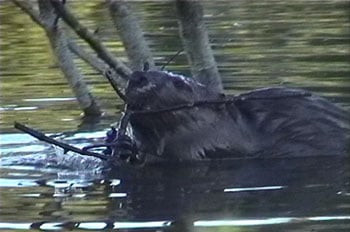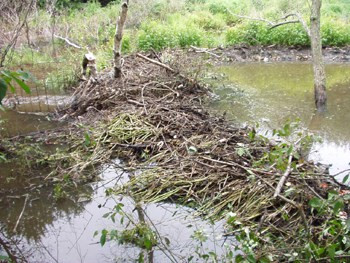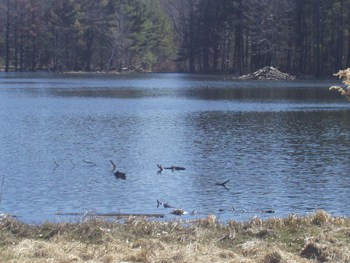Embarking on a journey to explore the fascinating world of beavers in Vietnam? Understanding the distances these industrious creatures travel from their lodges is key to appreciating their impact on the environment. How Far Do Beavers Travel From Their Lodge? Typically, beavers venture within a 0.5-mile (800 meters) radius of their lodge, primarily along waterways and sometimes extending up to 10 miles (16 kilometers) when seeking new territories. SIXT.VN makes your Vietnam travel seamless, providing expert guidance and services like airport transfers and hotel bookings to ensure a memorable experience. Discover Vietnam’s natural beauty with confidence, and let SIXT.VN handle the logistics. Explore Vietnamese wildlife and travel with ease.
1. Understanding Beaver Territory
Beavers, known scientifically as Castor canadensis, are the largest rodents in North America and are renowned for their dam-building abilities. Their territory is centered around their lodge and the surrounding waterways. Understanding the extent of their travel range is crucial for appreciating their ecological impact.
1.1. The Core Territory
The core territory for beavers is generally quite compact, focusing on the immediate vicinity of their lodge.
How far do beavers travel from their lodge on average?
On average, beavers typically stay within a 0.5-mile (800 meters) radius of their lodge. This area is where they primarily forage for food, maintain their dams, and ensure the safety of their lodge. This close proximity ensures they can quickly retreat to the safety of their aquatic environment if danger arises.
1.2. Factors Influencing Travel Distance
Several factors influence how far beavers travel from their lodge:
- Food Availability: If food is scarce near the lodge, beavers may need to travel further to find suitable vegetation.
- Pond Size: Larger ponds and waterways allow beavers to access more resources without venturing far from their lodge.
- Predator Presence: High predator activity can restrict how far beavers are willing to travel, keeping them closer to the safety of their lodge.
- Colony Size: Larger colonies may deplete resources faster, necessitating longer foraging trips.
Understanding these factors provides insight into the dynamic relationship between beavers and their environment.
2. Foraging Range
Beavers are primarily herbivores, feeding on the bark, leaves, and twigs of various trees, as well as aquatic plants. Their foraging range is directly linked to the availability of these resources.
2.1. Preferred Food Sources
Beavers have specific preferences when it comes to food.
What are the preferred food sources for beavers?
Their favorite trees include:
- Aspen
- Birch
- Cottonwood
- Maple
- Poplar
- Willow
They also consume aquatic plants like:
- Cattails
- Water lilies
- Sedges
- Rushes
The availability of these resources in the vicinity of their lodge will determine their foraging range.
2.2. Caching Behavior
To prepare for winter, beavers exhibit caching behavior, storing food underwater for consumption during the colder months.
How does caching behavior affect their travel distance?
During the fall, beavers stockpile sticks and branches underwater near their lodge. This food cache ensures they have a readily available food supply when the pond freezes over. Since they don’t hibernate, they need access to food throughout the winter. This behavior reduces the need to travel far from their lodge during the winter months, keeping them safe and well-fed.
 Beaver caching sticks underwater
Beaver caching sticks underwater
2.3. Optimal Foraging Theory
Optimal foraging theory suggests that animals will forage in a way that maximizes energy gain while minimizing energy expenditure.
How does optimal foraging theory apply to beavers?
Beavers will typically choose the closest and most abundant food sources to minimize the energy they expend while foraging. If high-quality food sources are readily available near their lodge, they will not need to travel far. However, if the nearby resources are depleted, they will venture further to find suitable alternatives.
3. Dam Building and Canal Construction
Beavers are renowned for their dam-building abilities, which create ponds that provide habitat, protection, and access to resources. They also construct canals to transport materials and access distant food sources.
3.1. Dam Site Selection
The location of a beaver dam is crucial for creating a suitable habitat.
Where do beavers typically build their dams?
Beavers prefer to build dams in areas with:
- Low-lying areas with shallow, moving water
- Natural or manmade anchors such as rock outcroppings or tree stumps
- Constrictions in the streambed
They avoid streams that are more than two feet deep or have strong currents.
3.2. Canal Construction
Beavers sometimes construct canals to extend their foraging range and transport materials.
How far do beaver canals extend?
These canals can extend over a hundred feet (30 meters), allowing beavers to access stands of their favorite trees and float edible branches back to the pond. This reduces the need to travel long distances on land, where they are more vulnerable to predators.
 Beaver dam built from sticks and mud
Beaver dam built from sticks and mud
3.3. Impact of Dams and Canals on Travel Distance
The construction of dams and canals directly impacts how far beavers need to travel.
How do dams and canals influence beaver travel distance?
By creating ponds, beavers ensure they don’t have to travel far on land to access new trees. The more area their dam floods, the more food they can safely access. Canals bring water closer to food sources, allowing them to swim up to trees and retreat to the water quickly if they sense danger.
4. Lodge Construction and Maintenance
Beaver lodges provide shelter, protection, and a central hub for the colony. The type of lodge and its maintenance influence how beavers use their surrounding territory.
4.1. Types of Lodges
There are two main types of beaver lodges.
What are the two main types of beaver lodges?
- Conical Lodge: This is the most recognized type, surrounded by water and made from sticks, mud, and rocks.
- Bank Lodge: Excavated into the bank of a large stream, river, or lake where the water is too deep or fast-moving to build a conical lodge.
The type of lodge they build depends on the environment they inhabit.
4.2. Lodge Structure and Function
The structure of a beaver lodge is designed to provide maximum protection and comfort.
What is the internal structure of a beaver lodge like?
Each lodge contains a chamber where beavers sleep, eat, groom each other, and nurse their young. Beddings of grasses, reeds, and wood chips are changed regularly. A ventilation shaft at the peak of the lodge allows fresh air to circulate. At least two water-filled tunnels lead from the chamber to the pond, allowing beavers to enter and exit the lodge underwater.
4.3. Influence on Travel Range
The lodge’s design and location influence how far beavers travel from it.
How does the lodge influence beaver travel range?
The lodge serves as a central, safe location, reducing the need for beavers to travel far for shelter or safety. With secure access to the water, beavers can easily access food and resources without exposing themselves to predators on land.
 Classic conical shaped beaver lodge
Classic conical shaped beaver lodge
5. Dispersal and Colonization
When beavers reach maturity, they often leave their natal colony to find a mate and establish their own territory. This dispersal phase can involve significant travel distances.
5.1. Dispersal Age and Motivation
Beavers typically disperse from their natal colony at around two years of age.
Why do beavers disperse from their natal colony?
This is driven by:
- The need to find a mate
- The desire to establish their own territory
- Competition for resources within the existing colony
5.2. Travel Distances During Dispersal
During dispersal, beavers may travel considerable distances in search of suitable habitat.
How far do beavers travel during dispersal?
Beavers have been noted to travel ten or more miles (16 kilometers) searching for a place to live. This is the most dangerous time in their lives, as they face increased risks from predators, cars, and territorial disputes with other beavers.
5.3. Habitat Selection
Finding suitable habitat is crucial for successful colonization.
What factors influence habitat selection during dispersal?
Beavers look for areas with:
- Plenty of water
- An abundance of food
- Suitable dam sites
- Low predator activity
Suitable beaver habitat only comprises 1 – 2% of the landscape, making it difficult to find uninhabited watersheds.
6. Social Behavior and Territoriality
Beavers are social animals with a strong family structure. They defend their territories against unrelated beavers to protect their food supply and resources.
6.1. Colony Structure
Each beaver colony typically consists of:
What does a typical beaver colony consist of?
- Adult parents
- Offspring from the current year (kits)
- Offspring from the previous year
The average number of beavers in an established family is typically six or seven.
6.2. Territorial Marking
Beavers mark their territories using scent mounds.
How do beavers mark their territory?
These are piles of mud with the adult’s castor oil mixed in. They act as warnings to any beaver that may be passing through the area. Adult beavers will defend their territory by attacking any beaver outside their family who enters it.
6.3. Impact on Travel Range
Territoriality influences how far beavers travel from their lodge.
How does territoriality impact beaver travel range?
To protect their limited food supply, beavers will not allow unrelated beavers to inhabit their pond. This reduces the need to venture far in search of resources, as they have exclusive access to the food within their territory.
7. Predators and Safety
Beavers face threats from various predators, which influence their behavior and travel patterns.
7.1. Common Predators
Common predators of beavers include:
What are the common predators of beavers?
- Coyotes
- Wolves
- Bears
- Lynx
- Eagles
- Owls
The presence of these predators affects how far beavers are willing to travel from their lodge.
7.2. Safety Strategies
Beavers employ various strategies to stay safe from predators.
What safety strategies do beavers use?
These include:
- Building lodges surrounded by water
- Constructing dams to create ponds
- Slapping their tail on the water to warn other beavers of danger
- Remaining close to the water
7.3. Influence on Travel Distance
Predator presence directly influences beaver travel distance.
How does predator presence affect beaver travel distance?
High predator activity can restrict how far beavers are willing to travel, keeping them closer to the safety of their lodge. They are more likely to forage in areas with dense vegetation or underwater, where they are less vulnerable to attack.
8. Seasonal Variations
Beaver behavior and travel patterns change with the seasons.
8.1. Spring and Summer
During the spring and summer, beavers are more active.
What are beavers doing in spring and summer?
They focus on:
- Building and maintaining their dams and lodges
- Foraging for food
- Raising their young
Food is typically abundant, so they don’t need to travel as far.
8.2. Fall
In the fall, beavers prepare for winter.
How do beavers prepare for winter?
They:
- Stockpile food caches underwater
- Repair their lodges
- Reinforce their dams
This reduces the need to travel far during the winter months.
8.3. Winter
During the winter, beavers remain inside their lodge.
What do beavers do in the winter?
They:
- Live on their cached food
- Swim under the ice to access their food supply
- Conserve energy
Travel distances are minimal during this time.
9. Human Impact
Human activities can significantly impact beaver populations and their behavior.
9.1. Habitat Loss
Habitat loss due to:
What causes habitat loss for beavers?
- Deforestation
- Urbanization
- Agriculture
Can reduce the availability of suitable habitat and increase the need for beavers to travel further to find resources.
9.2. Trapping and Hunting
Trapping and hunting can reduce beaver populations and alter their behavior.
How does trapping and hunting affect beaver behavior?
Heavy trapping pressure can make beavers more wary and less likely to travel far from their lodge.
9.3. Conservation Efforts
Conservation efforts can help protect beaver populations and their habitat.
What conservation efforts can help beavers?
These include:
- Protecting and restoring riparian habitats
- Managing beaver populations sustainably
- Educating the public about the ecological benefits of beavers
10. Frequently Asked Questions (FAQs) about Beaver Travel
10.1. How far do beavers typically travel from their lodge on a daily basis?
Beavers usually stay within a 0.5-mile (800 meters) radius of their lodge for daily activities like foraging and dam maintenance.
10.2. What is the maximum distance a beaver might travel from its lodge?
During dispersal, young beavers may travel up to 10 miles (16 kilometers) or more in search of new territories.
10.3. How do beavers navigate while traveling long distances?
Beavers rely on their excellent sense of smell and hearing, as well as their familiarity with the local waterways, to navigate.
10.4. Do beavers travel alone or in groups?
Beavers typically travel alone or in pairs when dispersing, but within their territory, they often travel with family members.
10.5. What time of day do beavers travel the most?
Beavers are primarily nocturnal, so they are most active and travel the most at night.
10.6. How do beavers protect themselves from predators when traveling?
Beavers stay close to the water, use their tail to signal danger, and travel in familiar areas to avoid predators.
10.7. What types of terrain do beavers prefer when traveling?
Beavers prefer to travel along waterways, as they are excellent swimmers and can quickly escape from predators in the water.
10.8. How does weather affect how far beavers travel?
Severe weather conditions, such as heavy rain or extreme cold, can limit how far beavers are willing to travel.
10.9. Do beavers from different colonies ever interact while traveling?
Interactions between beavers from different colonies are usually hostile, as they defend their territories against intruders.
10.10. What should I do if I encounter a beaver while hiking?
Observe the beaver from a distance and avoid approaching or disturbing it. Give it plenty of space to move away.
Understanding how far beavers travel from their lodge is crucial for appreciating their ecological role and behavior. From their core territory to their dispersal patterns, numerous factors influence their movements. By protecting beaver habitats and managing human impacts, we can ensure these fascinating creatures continue to thrive.
Ready to explore Vietnam’s natural beauty with ease? SIXT.VN offers comprehensive travel services, including airport transfers, hotel bookings, and tailored tour packages. Let us handle the details so you can focus on enjoying your adventure. Contact SIXT.VN today to plan your unforgettable Vietnam experience!
Address: 260 Cau Giay, Hanoi, Vietnam
Hotline/Whatsapp: +84 986 244 358
Website: SIXT.VN



